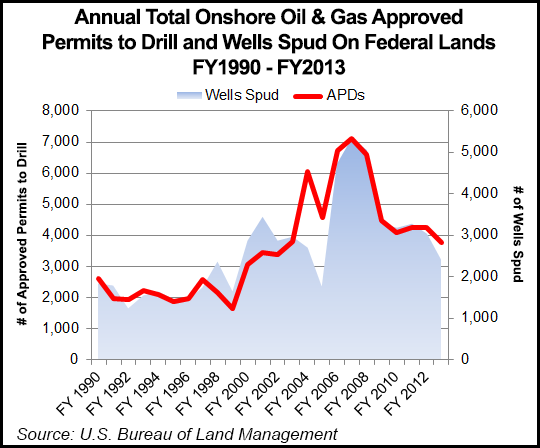NGI Archives | NGI All News Access
NatGas Industry Lauds President’s Renewed Bid to Streamline Permitting, Invest in Infrastructure
A renewed attempt by President Obama on Wednesday to invest in the nation’s aging infrastructure, as well as streamline the federal permitting process, now a slow-moving spaghetti loop of agencies and stakeholders, was lauded by the natural gas industry.

The administration on Wednesday outlined a four-part strategy to review and approve major construction projects on federal lands, as well as better coordinate agency activity. The strategy comes three years after the president issued an executive order to modernize and upgrade the nation’s infrastructure (see Daily GPI, July 13, 2011; Jan. 19, 2011).
A big push is to use more programmatic environmental impact analyses (PEIS), which basically encompass a single analysis for multiple projects, a method used more often today by oil and gas regulators. By using a PEIS to incorporate all of the relevant information for different government authorities, the theory is that permitting times and costs would be reduced. Several agencies whose authority overlaps or directly involves oil and gas activities already are using more combined analysis:
The natural gas industry and conservation groups said the time was right to streamline and reduce costs.
“We applaud the administration’s effort to improve permitting processes for infrastructure projects, by cutting timelines, reducing red tape, and promoting transparency through a modernized process,” American Gas Association CEO Dave McCurdy said.
Don Santa, who helms the Interstate Natural Gas Association of America (INGAA), also commended President Obama “for taking action…to modernize and upgrade our nation’s infrastructure, and particularly his efforts to streamline the federal permitting process to ensure timely approval of projects. While the White House fact sheet does not specifically mention pipeline projects, we hope the administration will work with Congress and various federal agencies to improve the permitting process for interstate natural gas pipelines. Pipelines are the key to America’s natural gas revolution because they are the indispensable link from the supply source to the ultimate gas consumer.”
The House already has passed HR 1900 sponsored by Rep. Mike Pompeo (R-KS) to aid the effort, Santa noted. That legislation establishes a 12-month deadline for federal and state agencies to approve pipeline applications (see Daily GPI, Nov. 21, 2013). The legislation is not expected to be considered in the Senate.
“This bill is consistent with the principal recommendation of the INGAA Foundation permitting report released in December 2012,” said Santa. The report indicated that the time needed to obtain required permits for interstate gas pipeline projects from federal agencies other than the Federal Energy Regulatory Commission had increased (see Daily GPI, Jan. 17, 2013).
“The report found that, while the Federal Energy Regulatory Commission does an effective job of reviewing applications to build new pipelines, it lacks the authority to enforce permitting deadlines for other federal and state agencies,” Santa said. “This deficiency increasingly is causing pipeline project delays. Providing clear permitting deadline authority will add certainty to the process and encourage timely decisionmaking.”
Natural Resources Defense Council Executive Director Peter Lehner also commended the call to streamline regulations.
“A plan to expedite the permitting of infrastructure projects that does not shortchange the environment or endanger wildlife is just what America needs,” Lehner said. “We look forward to working with all stakeholders to ensure that worthy projects focused on transitioning this nation to a clean energy economy are given a fair shot.”
© 2024 Natural Gas Intelligence. All rights reserved.
ISSN © 1532-1231 | ISSN © 2577-9877 |
